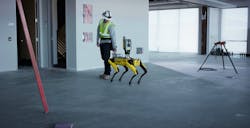Follow the leader: New following technology better equips robots for the jobsite
By David Malone, Associate Editor
Anyone with an irrational fear of a pending robot uprising may want to look away, because they have just taken one more step towards autonomy. Piaggio Fast Forward (PFF) and Trimble have announced a proof-of-concept collaboration to enable robots and machines to follow humans and other machines in industrial applications.
Many robots are currently controlled by joysticks operated in person or by telepresence from a remote location, but the new prototype eliminates the need for sole control via a joystick. The smart following technology allows humans to lead robots and machines in dynamic environments. “The follow-me technology by PFF provides an intuitive user experience and opens the door to collaborative robots that can augment the human workforce,” said Aviad Almagor, Division Vice President, Trimble’s Emerging Technologies, in a release.
PFF has componetized the smart following technology developed by PFF’s Gita robot into a stand-alone module called PFFtag. PFF and Trimble have integrated this patent-pending PFFtag smart following module prototype onto a Boston Dynamics Spot robot platform controlled by Trimble’s advanced positioning technology.
With the push of a button, a fused sensor array is activated and paired to a leader who navigates the robot or machine through construction or civil engineering spaces. PFFtag enables external partners to leverage its exclusive algorithms and allow their software to communicate with PFF’s software, enabling a human to control the robot via pairing and improving the robot’s ability to sense direction and velocity as it follows the leader. While on a site walk, waypoints can be dropped with the push of a button. Once trained by following, paths can be repeated by the robot autonomously with the ability to avoid obstacles and respond to a changing environment.
No app, tablet, or special training to operate a joystick is needed. Additionally, multiple robots or machines can be “linked” together like ducklings following their mother to create a platooning effect.
Trimble conducted testing using a Spot robot equipped with Trimble laser scanning or Global Navigation System sensors and PFFtag technology at one of its customer’s sites in Colorado over the course of two months as part of the proof-of-concept. In the future, PFF and Trimble envision robots with PFFtag having the ability to assist construction professionals in their daily workflow, carry heavy equipment, improve efficiency, and enhance worker safety.


